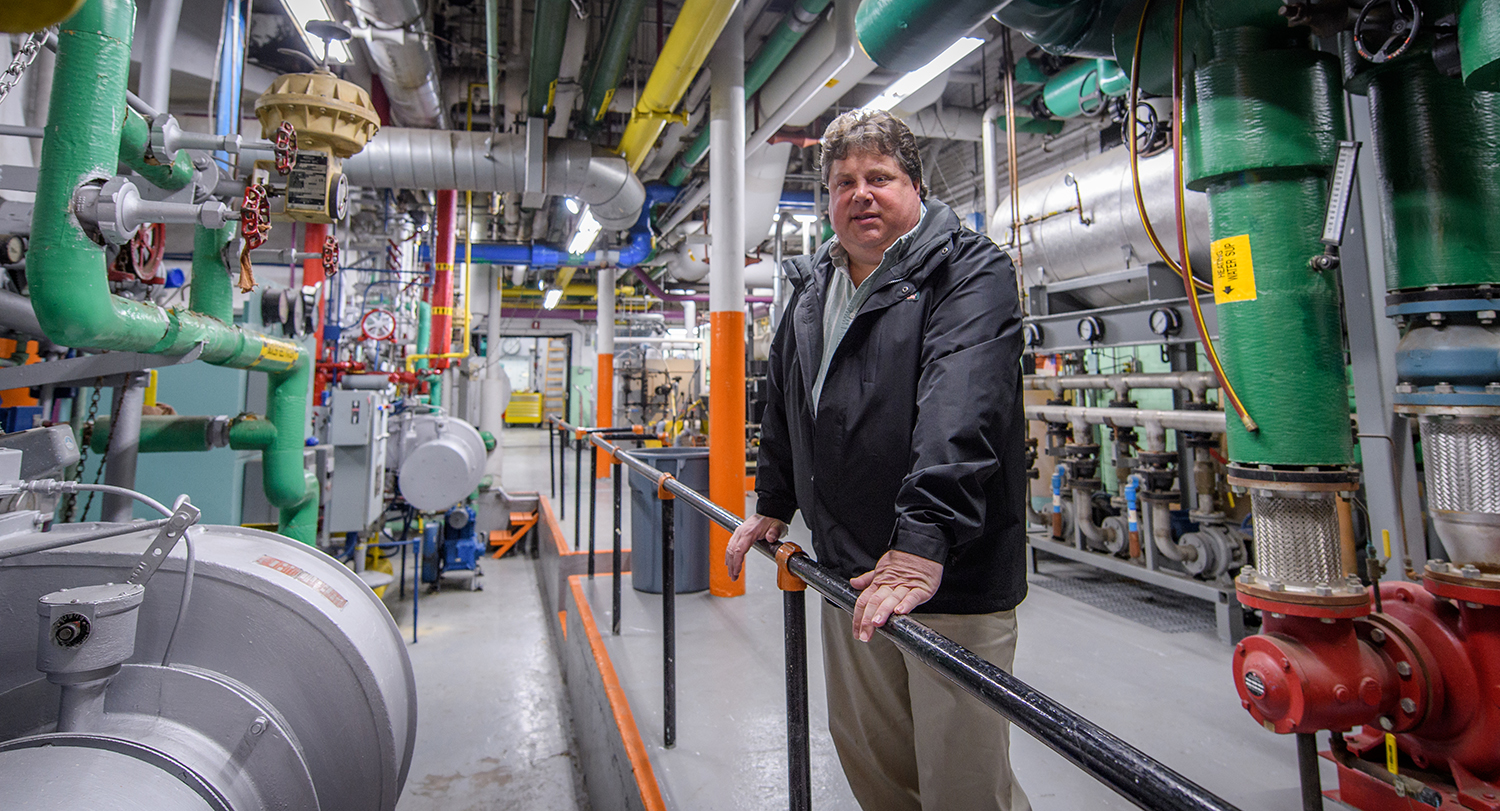Clark’s cogeneration plant is a model of efficient energy

Hidden beneath Clark University’s lawns, gardens, and walkways, a network of pipes and electrical cables snakes its way to the main campus buildings, ensuring hot showers and cooled air, steam, and electricity, day and night. How that energy is created is a point of pride in the university’s legacy of sustainable practices.
Much of Clark is powered by the cogeneration plant, which is housed in Jonas Clark Hall and managed by Mark Leahy, central utility plant chief engineer, and his team.
Nearly 40 years ago, Clark began construction on one of the first grid-connected cogeneration plants in the country, replacing a system of multiple boilers scattered throughout different campus buildings that operated independently. Since its completion in 1982, the plant’s massive engine has converted natural gas into whatever form of energy — such as steam for heat or electricity for lighting — is required at a given location. Waste heat produced when generating electricity is captured and reused, while surplus energy in the form of electricity can be sold to the electrical grid. (Electricity from the grid is also available as needed during periods of high usage.)
Leahy, who has been with Clark since 1996, “is widely recognized as a leader in the cogeneration industry,” says Dan Roderick, director of facilities management. He adds that Leahy successfully managed the installation of a replacement cogeneration engine in 2013 to supply more electricity, steam, and hot water through existing distribution lines.
At a recent workshop sponsored by Eversource, “How Colleges and Universities Cut Energy Costs with Combined Heat and Power,” Leahy shared his extensive knowledge of cogeneration technology. The event was attended by facilities leaders from area universities and businesses, as well as representatives from National Grid.
Leahy explained that an increasing number of institutions in the Worcester area, including hospitals and other colleges, are interested in converting to the cogeneration model, also known as combined heat and power, or CHP. And for good reason. He estimates that since its installation, Clark’s cogeneration plant has saved the university approximately $15 million — from $300,000 to $600,000 annually.
“Utilities are actually willing to help with the financing, and offer rebates,” Leahy says. “That’s what this workshop was about. Eversource wanted everyone to know there are lots of [CHP] incentives. And they wanted to let all these other colleges and universities and hospitals know that Clark is probably the best model out there.”
Anyone who wants a peek at the new cogeneration engine can view it through the large windows on the corner of Jonas Clark Hall, facing Goddard Library. Leahy also conducts tours of the plant, both for faculty who want to introduce their students to this form of energy generation, as well as area plant managers who are considering converting their facilities to the CHP model.
But you don’t don’t have to be part of a physics or engineering class to learn about cogeneration. Jenny Isler, Clark’s director of sustainability, leads an annual tour of the plant for staff and students.
“The continual improvements to the operation of Clark’s CHP plant, under Mark’s careful guidance, have made a significant contribution to the goals of the university’s Climate Action Plan,” Isler says. “Combined heat and power is an energy-efficiency powerhouse, and energy efficiency is the best way for institutions to reduce greenhouse gas emissions.”
The cogeneration plant was one of the factors that led to the university’s inclusion in The Princeton Review’s “Guide to 399 Green Colleges” in 2018.
From Clark Magazine: Read about Leo Breton ’85, who, while a Clark senior, was tapped by the Physics Department to determine why the new cogeneration plant was not operating at capacity.


